Contents
Mountain ash Pomegranate adorns many gardens of summer cottages and personal plots. It is valued not only for its decorative appearance. Useful properties of pomegranate rowan fruits are known to many gardeners. Its berries are a storehouse of useful substances, an effective remedy for many diseases. In addition, they have an impressive size and a very beautiful color, reminiscent of the color of pomegranate. Definitely, everyone should plant Pomegranate mountain ash on their site in order to always have a home doctor on hand, and a description of the variety and photos can be found in this article.
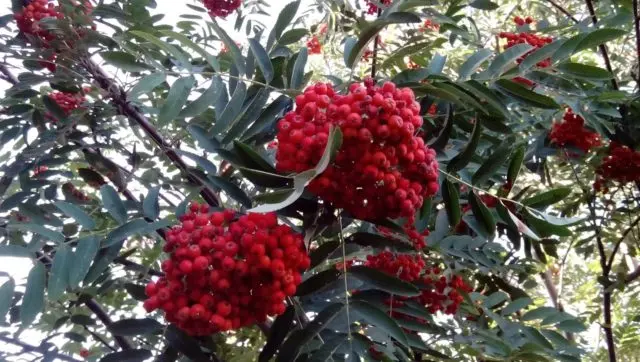
Description of the variety of mountain ash Pomegranate
Mountain ash Pomegranate is the result of the breeding work of Michurin I.V., who crossed Siberian hawthorn and mountain ash. The resulting hybrid was named Michurin’s Crataegosorbus (hawthorn). Later, due to its dark garnet-colored berries, the variety was named Rowan Pomegranate (photo).
Pomegranate mountain ash is a tall tree with a spreading crown, somewhat resembling mountain ash. The hybrid is characterized by a short duration of industrial cultivation, frost resistance and high adaptive qualities. The shoots of the tree are resistant to high and low temperatures, and are also distinguished by good maturation.
The variety belongs to light-loving crops, but it can also fully develop and bear fruit when growing in shaded areas. Mountain ash Pomegranate favorably stands out from a number of other varietal red fruits, the size of the berries and their original color. The decorative beauty of the tree is preserved all year round, including in winter.
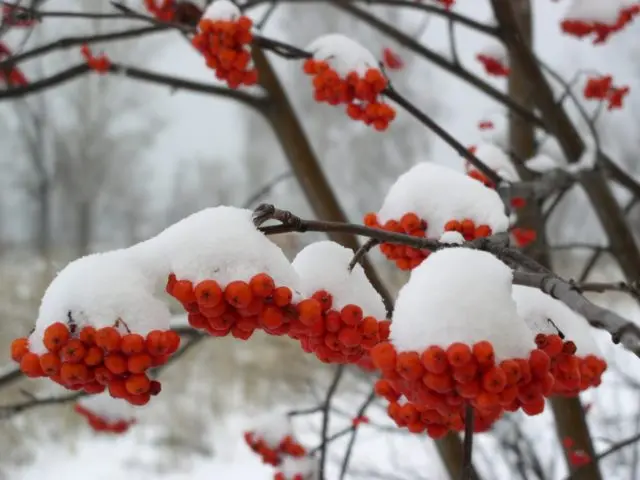
Description of varietal characteristics of mountain ash pomegranate:
- the average fruiting period is 20-25 years;
- the height of an adult tree is up to 3-4 m;
- the crown is dense, wide, decorative;
- spreading branches;
- foliage odd-pinnate, consisting of several shield-shaped leaves;
- type of fruit buds mixed;
- type of root system – fibrous;
- flowers are small, white, collected in semi-oval inflorescences;
- the shape of the fruit is spherical, with small edges;
- the color of the berries is burgundy-pomegranate, with a slight bluish bloom;
- average fruit weight 1-1,6 g;
- yield 20-25 kg per season;
- the taste of berries is sweet and sour, with a light, pleasant note of astringency;
- the pulp of the fruit is dense, yellow.
Pros and cons of the variety
Benefits of red mountain ash varieties Pomegranate:
- resistance to high and low temperatures;
- lack of bitterness in fruits;
- berries, leaves and bark contain a large amount of useful substances;
- high yield;
- large-fruited;
- self-fertility;
- precociousness;
- long-term storage;
- fruits are suitable for drying and freezing.
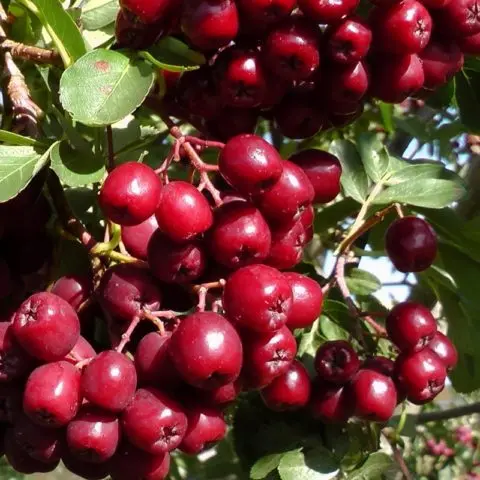
Disadvantages of pomegranate rowan:
- short life cycle of a tree;
- average resistance to diseases and pests;
- root sensitivity to damage;
- fear of strong winds, which is especially dangerous during the survival period.
Useful properties of pomegranate mountain ash
Rowan pomegranate is considered a medicinal plant. Its fruits, leaves and bark are used for the treatment of many diseases and for preventive purposes. Healing tinctures and decoctions are prepared from them. But before starting treatment with pomegranate mountain ash, you need to familiarize yourself with its beneficial properties and possible contraindications.
The fruits of rowan pomegranate are 80% water, but despite this, they contain a large amount of carbohydrates, proteins and organic acids (citric, malic and grape). They also contain essential oil, minerals and vitamins (B1, B2, C, A, P, E, K). Vitamin C, for example, is more in rowan pomegranate than in lemons. And in terms of the amount of carotene, rowan berries are ahead of carrots. The chemical composition is supplemented by such macro- and microelements as phosphorus, magnesium, potassium, iron, as well as flavone, tannin and pectin substances.
Mountain ash Pomegranate has a beneficial effect on the human body, so recipes based on it are often used to treat many diseases. The main useful properties of the plant are the ability to:
- improve blood clotting;
- reduce blood pressure;
- normalize cholesterol levels;
- remove toxins and heavy metals;
- regulate the work of the digestive tract;
- improve the functioning of the thyroid gland and liver.
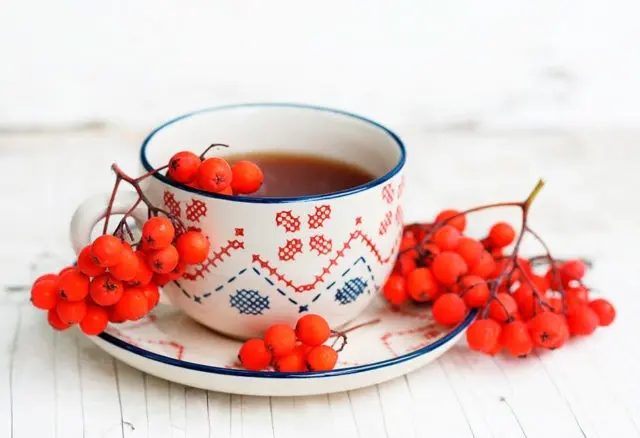
Application of pomegranate rowan
Mountain ash Pomegranate – a variety with edible and tasty fruits that can be canned, frozen and dried. From berries you can cook:
- juices;
- compotes;
- jelly;
- syrups;
- jam;
- jam;
- liqueurs;
- liqueurs;
- tinctures;
- wine.
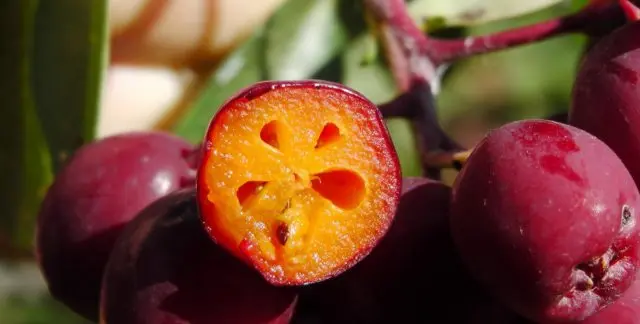
Planting and caring for mountain ash Pomegranate
Rowan Pomegranate is an unpretentious horticultural crop in cultivation, but requiring systematic care. Trees love light, need regular watering, loosening, periodic, but not frequent feeding and mulching. Carrying out all the necessary agrotechnical measures will allow you to get healthy, fully developing trees and a good, stable harvest.
Site preparation
The site for planting pomegranate mountain ash is best chosen sunny. It can grow in shady places, but the yield can be significantly reduced. The soil should be nutritious and well drained. The following types of soils are suitable for this variety:
- turf;
- sod-slightly podzoly;
- loamy
Rules for planting mountain ash Pomegranate
It is recommended to plant seedlings of pomegranate mountain ash in the ground in the fall, at the same time it is best to purchase planting material. Spring planting is also possible, but trees should be planted before bud break begins.
Step-by-step process of planting pomegranate rowan:
- Prepare a landing pit with a width of 1 m, a depth of 0,5 m.
- A mixture of fertilizers is placed in the hole (superphosphate – 350 g, potassium sulfate – 250 g, humus – 20 kg) and mixed well with the bottom layer of soil.
- The seedling is placed in the hole. The root neck should not be more than 5 cm below ground level.
- Fill the hole with soil, lightly tamping.
- The seedling is watered abundantly (water consumption is about 20 liters).
- Mulch the trunk circle. The thickness of the mulching layer must be at least 8 cm.
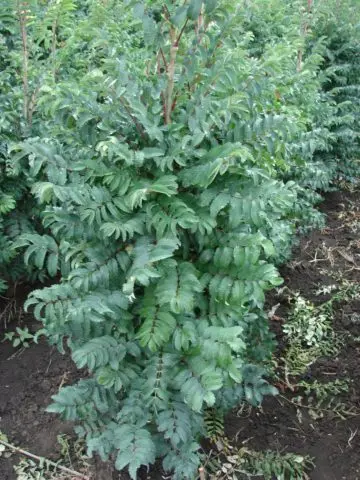
Watering and top dressing
Pomegranate mountain ash responds well to watering, but stagnant water can be fatal for it. Therefore, watering the trees is necessary only during a long dry period. With a sufficient amount of rain, watering adult trees is carried out:
- in early spring, during bud break;
- 3 weeks before ripening berries;
- 30 days after harvest.
Watering is carried out in the zone of the near-stem circle, in specially created grooves. Water consumption per 1 adult tree is about 30-40 liters. After each watering, the soil under the mountain ash is recommended to be fluffed and mulched. Loosening will prevent possible stagnation of water, and mulching will help keep the soil moist for as long as possible.
The amount of feeding depends on the age of the plants. Young pomegranate rowan trees are fed 1 time – in the spring, while digging the soil. More mature specimens need 2 top dressings – both in spring and autumn.
The following fertilizers are applied to the soil (based on 1 plant):
Young animals (up to 3 years old) | Adult trees |
Ammonium nitrate or urea – 25 g | Superphosphate – 50 years Potassium – 30 g |
Trimming
Pomegranate mountain ash is recommended to carry out such types of pruning as:
- sanitary – in order to remove broken, dry, damaged or diseased branches.
- formative, providing for the thinning of the crown and the elimination of root shoots and lower branches.
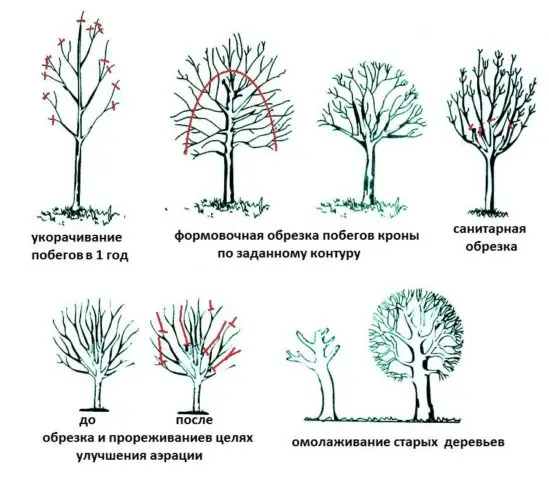
Proper crown formation can significantly increase the yield of rowan trees. In the first year, pomegranate rowan is cut into one kidney. Carry out the procedure in early spring, before they bloom. It is necessary to monitor the angle of departure of the branches. It shouldn’t be too sharp. Mature trees are pruned as needed, thinning the crown, removing excess branches and cutting them by 1/3.
Preparation for winter
In terms of winter hardiness, mountain ash occupies one of the first places among other fruit and berry trees. It tolerates harsh winters quite well, withstanding frost up to 50 ° C. Therefore, there is no need to carry out any activities related to the warming of trees. Preparation for winter involves only careful digging of the soil after harvesting.
Pollination
Rowan Pomegranate is a self-fertile variety, therefore, in principle, it does not need pollination. But cross-pollination can significantly increase yields. Most often, gardeners cross red pomegranate mountain ash with the following varieties:
- Sorbinka;
- Dessert;
- Bead;
- Wefed.
Harvesting
Pomegranate rowan belongs to early-growing varieties. Already in the 4th year after planting, the trees begin to bear fruit. The ripening of berries begins at the end of August. The variety has high yields, which is about 15-25 kg per 1 tree. The maximum shelf life of fruits in dry, cool rooms is 5 months.
Diseases and pests
The resistance to diseases and pests of the rowan variety Pomegranate is rather low. Therefore, it is very important to carry out preventive protective measures in a timely manner, and in case of damage, carry out the necessary treatment.
Diseases and pests | Evidence | Preventive measures (treatment) | Treatment | Carrying out period |
Rowan gall mite | Foliage damage, blisters (galls) | Solution 0,1% “Rogora-S” (1 l per 1 m2) | Colloidal sulfur – 1% solution | Before flowering |
rowan moth | Goose damage to berry pulp | Digging up the trunk circle. Collection and disposal of damaged berries |
| in autumn |
| Chlorophos 0,2% (20 g/10 l water) | 14 days after flowering | ||
rowan aphid | Leaf deformation | 2% solution of nitrafen (300 g/10 l of water) | 0,2% solution of karbofos (75 g / 10 l of water) | In the summer, before fruit set |
Mučnistaâ rosa | White bloom on leaves | Cutting off and burning all affected leaves. Treatment with colloidal sulfur solution (30 g/10 l water) |
| Before flowering |
| Soap and soda solution: 10 liters of water, 3 tablespoons of baking soda, 3 teaspoons of liquid soap | Every 4 days, until the symptoms of the disease disappear completely | ||
Moniliasis | The defeat of the whole tree, the appearance of dark gray growths | Cut and burn the damaged parts of the tree | nitrafen (300 g/10 l of water) or blue vitriol (100 g/10 l of water) | Until the dissolution of the kidneys |

Reproduction
Rowan pomegranate propagates by grafting or budding (cuttings, arc layering or root offspring). Budding is best done at the end of July in order to be able to prune grafted plants in mid-spring (April). So that the trunks are not twisted, pruning should be carried out on a spike. The resulting cuttings in the spring can be grafted onto ordinary mountain ash, thereby ennobling it and improving varietal qualities.
Pomegranate grafting can be done in the following ways:
- into cleavage;
- in a side cut;
- as an example
Reproduction by arc layering is carried out in this way:
- The lower branches bend down to the ground.
- Attached with pegs. The end of the branch should be slightly curved.
- The branch is sprinkled with soil.
It is necessary to ensure that the soil is always well moistened and loosened. You can separate the layers from the tree after 2-3 years.
Conclusion
Rowan Pomegranate is a fruit tree that will not only adequately decorate a garden and a personal plot, but will also delight you with a harvest of delicious, vitamin berries. The variety is not afraid of frost and can grow in any climatic zone. The culture is unpretentious in care, so even beginners in gardening will not have problems with its cultivation.









